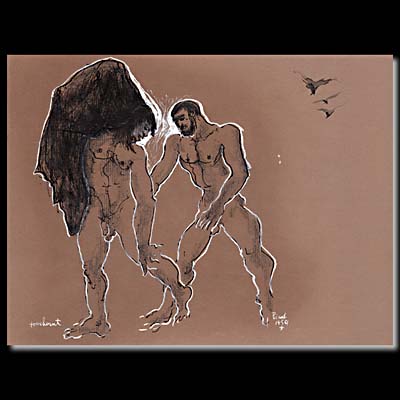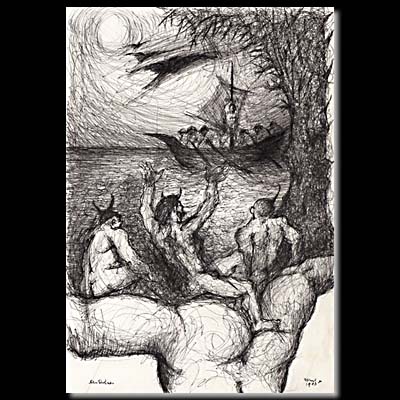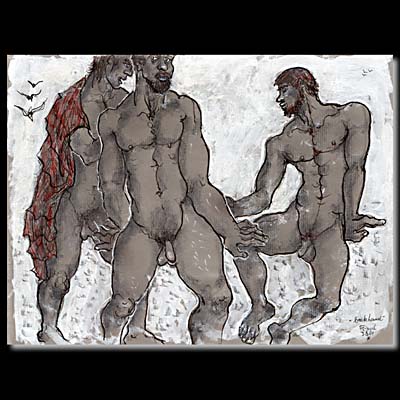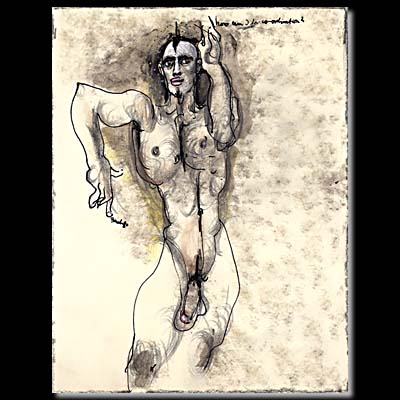| Home |
 Decision |




















A book launch was held at Ménage a trois book store 1672 Ste. Catherine St. E. in Montreal on October 17th 2008 at 7 PM. Peter Flinsch and Ross Higgins were in attendance and available to sign customer copies.
Original works from the book are available from
peterflinsch.com.
From October 16th to November 6 Peter Flinsch's
works will be on display at
the Galerie Dentaire, 1239
Amherst St. Montreal, QC, H2L 3K9. Tel: 514-523-5535
In the November 4, 2008 issue of The Advocate there is an article entitled The Education of Peter Flinsch
Read it here in French.
Read it here in French.
On September 15th 2006 Peter Flinsch received the first Leslie/Lohman Lifetime Achievement Award at the New Leslie/Lohman Gay Art Foundation Gallery in New York City. The ceremony was held during his career retrospective show: LES IMAGES: THE ART OF PETER FLINSCH at the same gallery.
|
Peter Flinsch drew and painted the male nude for over 60 years. He was forced to come out as a gay man when he was 22. He started doing nude male art after the Second World War. He began drawing and painting male nudes for himself and for other gay men. He was happily surprised when his friends - most of them gay men - started buying his drawings and paintings of naked men. He began to make a small income selling naked art!
It wasn't until he started doing male nudes that he felt he had something to say as an artist. He had always had a talent for drawing. H was forced to admit the fact that he was a gay man during the Second World War, and had to accept that he was attracted to men. He was an openly gay artist who specialized in male nudes. He accepted himself, and he started drawing his passion, the male figure. Male nudity became his theme and main subject. When drawing (or painting) a naked man, he finally felt he was fulfilling his purpose as an artist. That gave him a new sense of freedom and satisfaction.
No one doubted him when he began painting nude men. He wasn’t bothered by his name being identified with male nudity. He couldn’t care less if people associated him with naked gay men, or naked straight men. He wanted to be known for creating pictures of nude men. Almost as soon as he started painting and drawing male nudes, he felt a sense of rightness, as if this were what he was put here to do: create male nude art.
Was he a gay artist? Is what he did gay art? Is it homoerotica? It seems to be a big question for many people. You could look at it several ways. Gay men buy his art, because gay men seem to enjoy seeing a man nude. And he was a gay man creating art for gay men. So you could call what he did gay art. But just painting a man nude doesn't make that painting gay art. A gallery filed with nude male paintings is not necessarily a gay gallery. Nude male art is not necessarily nude gay art. For Peter Flinsch the bottom line was, does the art move you? Does it grab you by the balls? Whether you're a gay male or not he was done his job as an artist. Whether you consider him a gay artist or not he was enjoying himself.
Poor Peter! He spent his artistic working time seeing men nude in his studio. He got to watch while some of the most beautiful men in the world get naked for him. Whether it's a naked gay man or a nude straight man didn't make much difference. He loved seeing it. So it's only natural that, having a talent for capturing what he saw on paper or canvas, he would enjoy taking that thing he loved to see - male nudity - and creating art from it. Additionally, he thought contemporary culture would get over its fear of the male nude, and he liked to confront that. He believed that by putting more nude male paintings out there, people would get more used to them and less afraid of them. The naked male body is a beautiful thing. Why not look at it? The world needs more nude men! And more nude men paintings too!
He preferred to paint young, fit, athletic male nudez, and they were usually muscular men. They were Caucasian, Asian, African - American, Hispanic, Latino, black, white, Japanese, blond, brunette, light - skinned or dark. They were naked Native Americans, surfers or naked construction workers or naked gay men or naked straight men but mostly naked body builders and athletes from the Y. M. C. A. What he was interested in was: does looking at this naked man make my heart beat faster? If so, that's model material. That's a man he wanted to paint. And by the way, the nude model didn't have to be gay. He was not necessarily making gay male paintings - He was making male paintings.
He produced erotic art. As far as he understood it, homoerotica, or gay erotica, simply erotica, has as its purpose: to cause sexual excitement in the viewer. Just because a painting is depicting a man naked doesn't mean that the painting is sexual. If the viewer is so easily triggered that even the sight of a naked man in a work of art gets him (or her) sexually excited, then the fact of his or her sexual excitement is not about the art, it's about the viewer's background. He hoped, in contemporary Western society, that the majority of viewers of art could distinguish between a painting or drawing of a man who happens to be nude, and a painting or drawing that has a specifically sexual content and whose intention is to provoke sexual excitement. That's not the case with most of his male nudes. Most of his male nude art is not so much sexual as sensual nude male art. It's not about causing sexual excitement so much as about giving the viewer an opportunity to enjoy the beauty of the male body.
Not a hard question to answer. He liked the way a naked man looks from the front. He liked the shape of everything there - the way the torso joins the hips, the Greek line, the beauty of a powerful chest with protruding nipples, the ripples of a well developed set of abdominals, the way the trail of hair begins at the navel and moves down toward the crotch, and oh yes, the beauty and individuality of every set of genitalia. The way the penis hangs over the balls, the way it swings when he walks, the way it changes size as the naked man changes moods. He liked painting and drawing buttocks as well. But a frontal nude is more powerful. And he liked bold, he liked strong, he like powerful. That's why so much frontal nudity!
Believe it or not, he painted subject matter other than just male art. He did landscapes, both realistic and stylized. (He painted many scenes of Africa, and because he traveled quite a bit, He was also done landscapes of Germany, Canada, France, Southern Africa, and many other places.) He also created abstract paintings and non - nude male figures. Like paintings of shirtless men, men in underwear men in Speedos. Men with clothes on! A painting of a clothed man can still be sensual male art. He loved painting the male nude, and he loved seeing men naked, but he also loved a beautiful landscape. Even when there's not a naked man in it!
He was often asked, "Are your nude models straight or gay?" His answer was “both gay and straight men model nude for me”. He found models everywhere, on the beach, in the YMCA locker room, in clubs and bars and at bus stops. When he saw a potential model, he didn't ask himself, “Is he a gay man?” or “Is he a straight man?”. He ask himself, “will he look great naked?” He didn't paint a naked gay man or a naked straight man, he painted a naked man. He didn’t paint naked homosexual men or naked heterosexual men, he painted naked men. What we present with his web gallery is not a gay men gallery, or a straight men gallery, it's a gallery of nude men. Every work in his web store is available to buy, to add to your collection of nude male art.
Do you Have Prints or Posters? He usually drew in pen and ink, watercolor, pastels and mixed media and sometimes acrylic on paper. He painted with oils or acrylic on canvas. Few of his many original works were produced into prints and posters, and these are very reasonably priced.
He wasn’t practical. He preferred to work with live models. He didn’t take photographs of his models, then work from the photographs at his leisure. He liked painting models in landscapes. He posed the naked man in his studio and drew the landscape from memory. In his studio he posed nude men with natural northern light or used artificial illumination. His art was not composed through the lens of a camera but by his minds eye. This is not to say that he didn’t appreciate fine male photographic art. In his private collection he had a fine art nude male photograph by Carlos Quiroz. Carlos showed Peter some contact sheets of his erotic nude male photography and Peter selected one frame that he liked. Once printed, the large photograph of the upper body of the nude young man figured prominently in Peter’s living room.